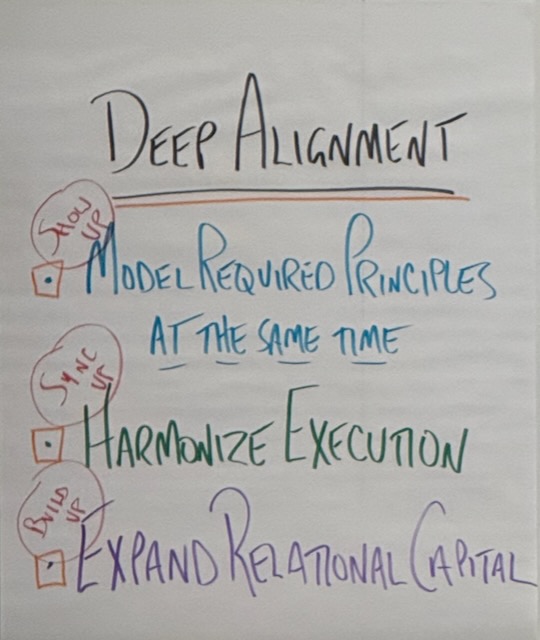Last week I had an opportunity to participate in a powerful leadership workshop led by Craig Ross from Verus Global. It was energizing, insightful, and packed with practical tools to help grow as a collaborative leader.
We focused on two core imperatives that must work together:
- Business: 3-6 months outcomes, like launching our new enterprise cloud platform and modernizing our existing product portfolio.
- Human: How we work together to get there, through collaboration, accountability, and leadership that’s both empowered and empowering.
Success happens when we align deeply with both. It starts off by agreeing on a shared reality, then moving forward with empowered decision-making along with real cross-functional execution.
What is deep alignment?
Highly aligned companies grow revenue 58% faster, and are 72% more profitable. On the other hand, misaligned ones lose an average of $109 million for every $1 billion invested.
Most organizations are structured vertically—people are grouped by department, and leadership flows top-down. While this provides structure, it also creates silos and slows collaboration. We often reinforce vertical alignment in ways we don’t even notice:
- Building relationships mostly within our own teams
- Chasing goals handed down from the top
- Having our performance, compensation, and careers shaped by those above us
Deep alignment builds human connectivity across these silos by relating to each other horizontally- not just vertically.
Modeling shared behavior and values: Show Up
- Respect, listen to, and trust each other.
- When discussing issues or concerns, we choose to connect first, then share content. Content is impersonal—connection builds context.
- Align through collaboration, which we define as the process of co-creating new knowledge and solutions together.
Other alignment styles exist, but each has limits:
- Top-down: leadership decides (efficient, but not always inclusive)
- Consensus: everyone agrees (slow and often impractical)
- Crisis: urgency forces alignment (not sustainable)
- Democratic: everyone votes (rarely used in practice)
Harmonize execution: Sync Up
- Adopt a shared framework like SAFe (Scaled Agile Framework).
- Hold regular cross-functional planning sessions.
- Maintain a transparent backlog with a shared definition of done.
- Deliver demonstrable, incremental value to stakeholders in every iteration.
Expand relational capital: Build Up
- Form cross-functional groups (e.g., Architecture, Security, Project Management).
- Share knowledge through lunch & learns, hackathons, and shared communication channels.
- Collaborate proactively—reach out before issues escalate, not
after.
- A sobering but important lesson is learning to recognize the difference between complex and complicated. Business problems are often complex, but operating in silos can make them unnecessarily complicated.
- For example, a data processing team might take on expensive data-cleaning tasks when the real solution could be as simple as changing a few text fields in the UI. Without collaboration, problems get solved in the wrong place.
- Cross-functional alignment helps address the right problems at the right level, making solutions simpler and more effective.
